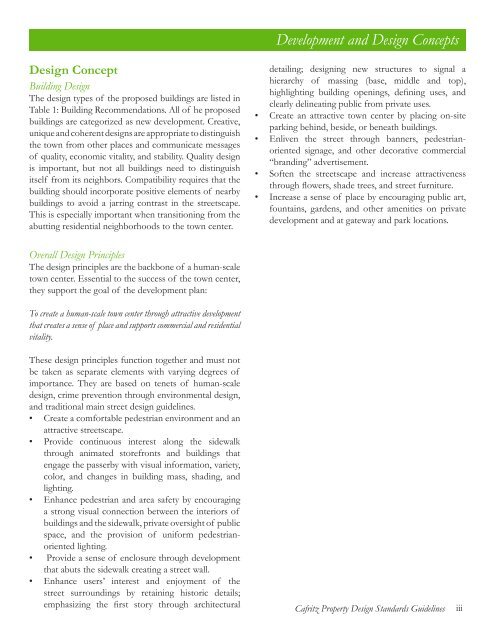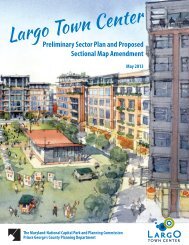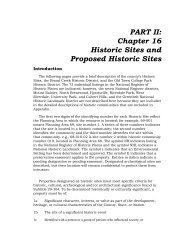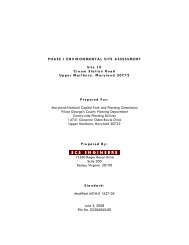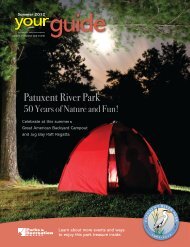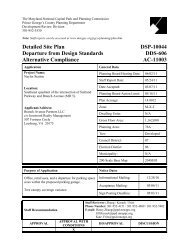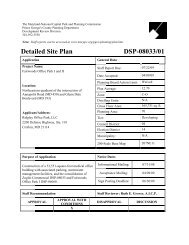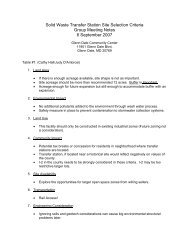Design Standard Guidelines - Prince George's County Planning ...
Design Standard Guidelines - Prince George's County Planning ...
Design Standard Guidelines - Prince George's County Planning ...
Create successful ePaper yourself
Turn your PDF publications into a flip-book with our unique Google optimized e-Paper software.
Development and <strong>Design</strong> Concepts<br />
<strong>Design</strong> Concept<br />
Building <strong>Design</strong><br />
The design types of the proposed buildings are listed in<br />
Table 1: Building Recommendations. All of he proposed<br />
buildings are categorized as new development. Creative,<br />
unique and coherent designs are appropriate to distinguish<br />
the town from other places and communicate messages<br />
of quality, economic vitality, and stability. Quality design<br />
is important, but not all buildings need to distinguish<br />
itself from its neighbors. Compatibility requires that the<br />
building should incorporate positive elements of nearby<br />
buildings to avoid a jarring contrast in the streetscape.<br />
This is especially important when transitioning from the<br />
abutting residential neighborhoods to the town center.<br />
detailing; designing new structures to signal a<br />
hierarchy of massing (base, middle and top),<br />
highlighting building openings, defining uses, and<br />
clearly delineating public from private uses.<br />
• Create an attractive town center by placing on-site<br />
parking behind, beside, or beneath buildings.<br />
• Enliven the street through banners, pedestrianoriented<br />
signage, and other decorative commercial<br />
“branding” advertisement.<br />
• Soften the streetscape and increase attractiveness<br />
through flowers, shade trees, and street furniture.<br />
• Increase a sense of place by encouraging public art,<br />
fountains, gardens, and other amenities on private<br />
development and at gateway and park locations.<br />
Overall <strong>Design</strong> Principles<br />
The design principles are the backbone of a human-scale<br />
town center. Essential to the success of the town center,<br />
they support the goal of the development plan:<br />
To create a human-scale town center through attractive development<br />
that creates a sense of place and supports commercial and residential<br />
vitality.<br />
These design principles function together and must not<br />
be taken as separate elements with varying degrees of<br />
importance. They are based on tenets of human-scale<br />
design, crime prevention through environmental design,<br />
and traditional main street design guidelines.<br />
• Create a comfortable pedestrian environment and an<br />
attractive streetscape.<br />
• Provide continuous interest along the sidewalk<br />
through animated storefronts and buildings that<br />
engage the passerby with visual information, variety,<br />
color, and changes in building mass, shading, and<br />
lighting.<br />
• Enhance pedestrian and area safety by encouraging<br />
a strong visual connection between the interiors of<br />
buildings and the sidewalk, private oversight of public<br />
space, and the provision of uniform pedestrianoriented<br />
lighting.<br />
• Provide a sense of enclosure through development<br />
that abuts the sidewalk creating a street wall.<br />
• Enhance users’ interest and enjoyment of the<br />
street surroundings by retaining historic details;<br />
emphasizing the first story through architectural<br />
Cafritz Property <strong>Design</strong> <strong>Standard</strong>s <strong>Guidelines</strong><br />
iii


